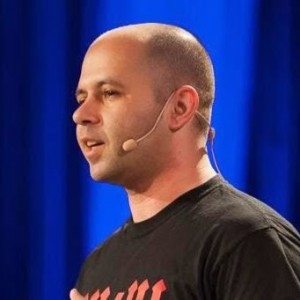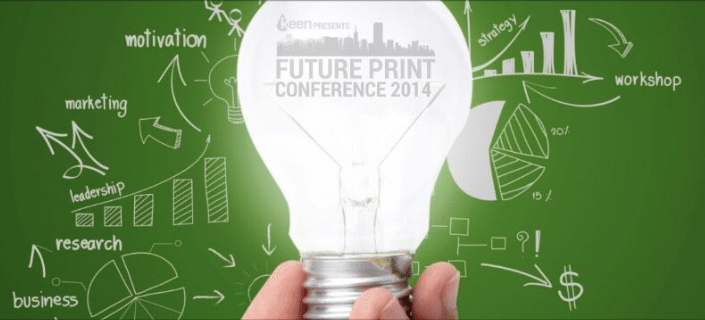A few years back I stumbled upon a tweet with three simple words, “Print Is Big” and a link. After clicking, I basically went into sharing overdrive, and tracked down the people behind it – Keen. After a little digging there I found Vitaly, and the rest is history!
I know some people out there with travel schedules, but none as exotic at Vitaly’s! Even for this interview I received information from him from JAKARTA! I do believe it’s that global perspective that gives Vitaly a perspective of the industry most of us will never see ourselves, and also makes him a perfect person to start a conference about the Future Of Print.
I found his personal history pretty fascinating, and I do recommend if you ever see him out and about you say hello and strike up a conversation. He is a pretty interesting guy… well just read the interview, you’ll see!
 DC: Who is Vitaly Golomb and what does he do?
DC: Who is Vitaly Golomb and what does he do?
VG: My family immigrated from Odessa, Ukraine to San Francisco when I was 8 years old. I started very early with computers because my father freelanced as a mechanical engineer and we had a good computer at home. By junior high I was messing around with bulletin board systems (which predated the world wide web). My best childhood friend and I were noticed by his father who was running the company that is best known for the handwriting recognition on the Apple Newton. We became pre-teen interns and got early exposure to Silicon Valley trade shows and the startup world at large. At 15, I became the youngest employee of Kinko’s (where I worked for Jennifer Matt). A year later I opened a neighborhood print shop with my father (digital, offset, wide-format). While in college, I ended up at fast-growing enterprise software company where I led the user interface design team.
I started at Santa Clara University in Communications and transferred to Cogswell College to earn a degree in Computer and Video Imaging. Also, in 2001 the startup nuclear bomb exploded in Silicon Valley and I came back to take over the print shop I originally founded with my father while he moved on to a medical device startup of his own. By 2005, I tripled it in size and sold it to a larger competitor. I then started a design firm with a partner in San Francisco which quickly grew to an additional office in Los Angeles and a development team in Eastern Europe. We landed a number of high-profile projects including Namco (PacMan) and Oakland Raiders. I was still known for print and we built up a decent print-brokering business… almost accidentally. We started building software to manage our own print business and that eventually spun out as Keen in 2010 which I decided to head-up full-time then.
We’ve subsequently raised a couple of rounds of venture capital and have grown to two offices (San Mateo, California HQ and Kyiv, Ukraine engineering center). Keen is now well-known in the industry with the several awards we’ve received for our disruptive approach. We still consider ourselves in the early stages, are growing fast, and have lots of REALLY interesting things coming down the pipe.
I’ve been involved with startups since a very young age so it was inevitable that I would get pulled-in to mentor the next generation. I give back to the community by spending time with a half-dozen accelerators, including 500 Startups (the world’s leading and a Keen investor). Along-side running Keen, I find myself traveling to ~20 countries, speaking at numerous conferences, and putting on one of the largest startup events (Startup AddVenture) in Europe every December.
DC: How does your W2P system set you apart from the others?
VG: Keen has two audiences and is uniquely “bi-lingual”… on the one hand we are disrupting print by aggressively pushing towards where the industry is headed… on the other we are a Silicon Valley, venture capital-backed technology company. As a startup we are really in a different technology class. We’ve designed for massive scale from day one and our platform is built similarly to things like Twitter or LinkedIn. Besides efficiencies on the IT side, we will be introducing more and more network effects never before seen in print. We also have more hands-on print experience in the company than a typical web-to-print shop. This allows Keen to design a solution that is more practical and supports the way printers actually work on a day-to-day basis.
DC: Im not sure everyone knows that you are the mastermind behind Print Is Big… why did you take “eco” on, and HOW is your awesome site created? HTML5?
VG: Most people in print cringe at the green washing campaigns they see every day and they’ve have to always play defense with their customers’ perception of print. My personal pet peeve was the “If you care about the environment, don’t print this email” footer. For me it was the last straw where I received an email from someone in the industry with it. At that point we decided that the industry needs a simple and strong way to communicate the facts about print’s ecological footprint and importance to business. A number of associations have taken an academic approach to this and that just usually puts people to sleep. Infographics have become very popular because they are art and easy to share. So we gathered the data, designed the flat print version of it for printers to download and print for self-promotion and created an interactive version of it on our site. At the time when we launched the site, “parallax” (multiple layers scrolling at different rate to create a 3d effect) was a very new trick. You can never underestimate the “wow” factor and for Print Is Big it has proven to be a great trojan horse to spread a very important message. The site is built with HTML and Javascript.
DC: What is The Future Print Conference, and how did it come about?
VG: Our style has always been to march to the beat of a different drummer. If for nothing else, really to just stand out from the large boring crowd of products in the industry. Conferences are usually much more interesting for the audience than some expos because the interaction is a lot less sales pitch, curated speakers provide great insights, and the networking is much more intimate. We felt that there is a gap in the industry both in focusing on strategies of what’s next and a major event on the west coast. We hope that our attendees will come away with a greater context on how to continue evolving their business strategically and its relationship to the constantly changing, increasingly more digital, marketing mix.
DC: In an “elevator pitch” format – Why should people attend Future Print?
VG: Traditional and digital marketing are converging, and the print industry must embrace the new marketing mix to survive. The Future Print Conference 2014 brings together innovative leaders from print, online marketing, and social media to talk about where marketing is headed and the cutting-edge techniques savvy marketers use today. Come learn how your company can take advantage of online marketing, web-to-print, search engine optimization, and other strategies to maximize business and crush cost. It’s time to evolve: come see the future of print.
DC: Looking towards the future, and tapping into your Venture Capitalist crystal ball – what types of investments should the printing industry be making (besides in your W2P software of course)?
VG: The most important thing is that printers stop working so much IN their business and start working ON it. Like most small business owners, many printers get scared by uncertainty and change. However, it is important to get your head out of the sand and make your competitive advantage. Embrace new techniques, tools, and opportunities. Be a leader. Take risks. Never stop learning.
Connect with KEEN on Facebook / LinkedIn / Twitter and follow #futureprint14
Visit here for Future Of Print Conference Registration












